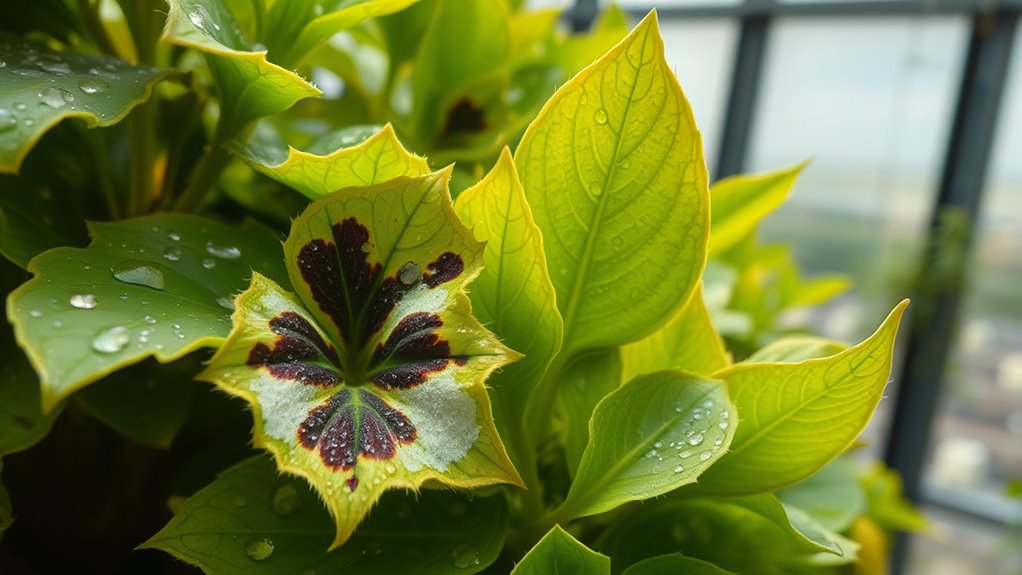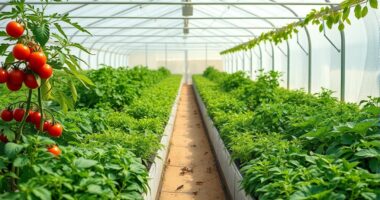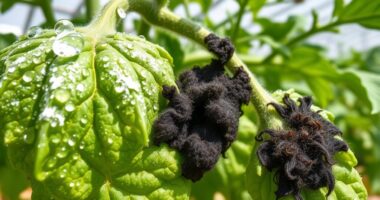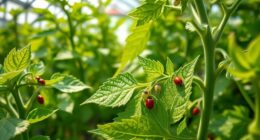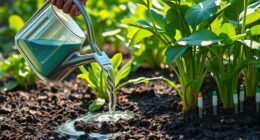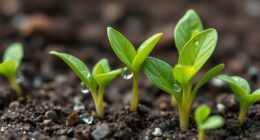Greenhouse plants face fungal, bacterial, viral diseases, and pest issues that can cause leaf spots, mold, wilt, and decay. Signs include discoloration, fuzzy patches, sticky residues, holes, or distorted growth. To protect your plants, maintain good sanitation, control humidity, guarantee proper watering, and monitor regularly. Early detection and addressing problems quickly are key. If you want to know more about specific diseases and effective treatments, keep exploring these essential tips.
Key Takeaways
- Common greenhouse plant diseases include fungal, bacterial, and viral infections, each with specific symptoms and prevention methods.
- Fungal diseases often show fuzzy spots or discolored patches; maintaining proper air circulation and avoiding overwatering helps prevent them.
- Bacterial infections present as wilting, soft rot, or dark streaks; sanitation and removal of infected tissue are essential for control.
- Viral diseases cause mottled leaves and stunted growth; early detection and quarantine of infected plants minimize spread.
- Regular inspection, good hygiene, balanced watering, pest management, and environmental control are key to treatment and prevention.
Common Fungal Diseases in Greenhouse Plants

Have you ever noticed fuzzy spots or discolored patches on your greenhouse plants? These symptoms often indicate common fungal diseases that threaten plant health. Fungal infections can spread quickly if you don’t manage water conservation carefully, as excess moisture encourages fungal growth.
To protect your plants, guarantee proper air circulation and avoid overwatering, which can compromise plant nutrition. Fungi thrive in damp conditions, so maintaining a balanced watering schedule helps prevent outbreaks. Additionally, understanding plant disease mechanisms can help you implement more effective prevention strategies. Recognizing early signs like spots or mold allows you to act swiftly, reducing the need for chemical treatments. Implementing water management practices that control humidity levels can further inhibit fungal development and promote plant vigor. By focusing on water conservation and providing ideal plant nutrition, you create an environment less hospitable to fungi, keeping your greenhouse healthier and more productive. Moreover, applying preventive measures based on disease lifecycle knowledge can significantly reduce infection risks. Implementing integrated pest management strategies can further enhance your efforts to maintain healthy plants.
Bacterial Infections and Their Signs
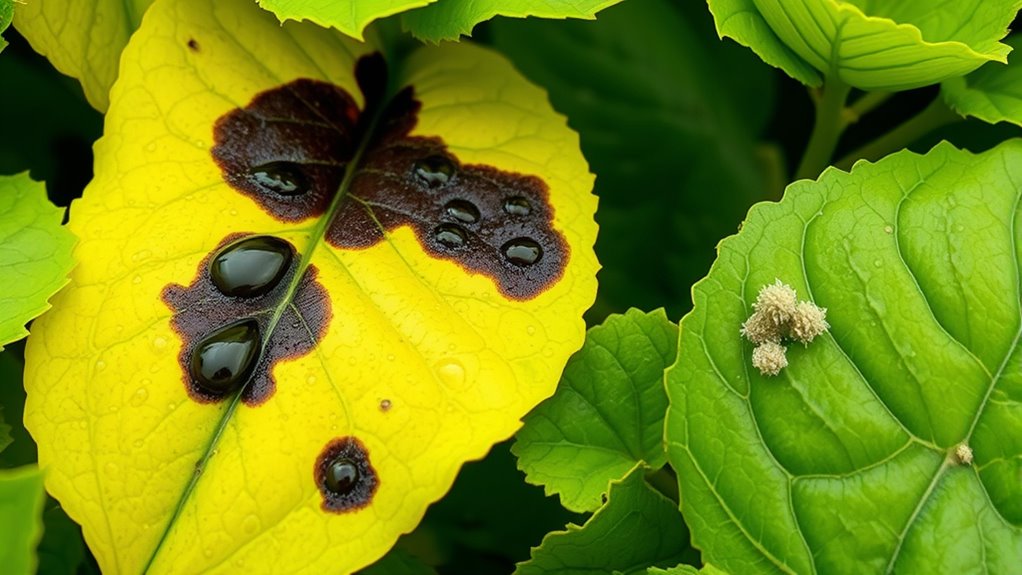
Bacterial infections can quickly undermine the health of your greenhouse plants if left unchecked. You might notice symptoms like wilting, which often indicates bacterial wilt, especially when plants suddenly droop despite adequate watering. Choosing the right USB cable type can be essential for maintaining equipment used for monitoring plant health and diagnostics. Soft rot is another common sign, where tissue becomes water-soaked, mushy, and emits a foul odor. You may see dark, slimy streaks or patches on stems, leaves, and roots. These infections spread rapidly through water, tools, or contact with infected plants, emphasizing the importance of proper sanitation practices. Early detection is vital; look for sudden wilting, discoloration, or decayed-looking areas. If you observe these signs, remove and destroy infected plant parts, disinfect your tools, and improve air circulation. Understanding plant disease spread mechanisms can help you implement better prevention strategies. Being aware of common bacterial pathogens can guide you in choosing appropriate treatments. Recognizing the signs of bacterial infection early can significantly reduce the risk of widespread damage, so stay vigilant and regularly inspect your plants. Prompt action helps prevent bacteria from spreading and saves your greenhouse plants.
Viral Diseases Impacting Greenhouse Flora
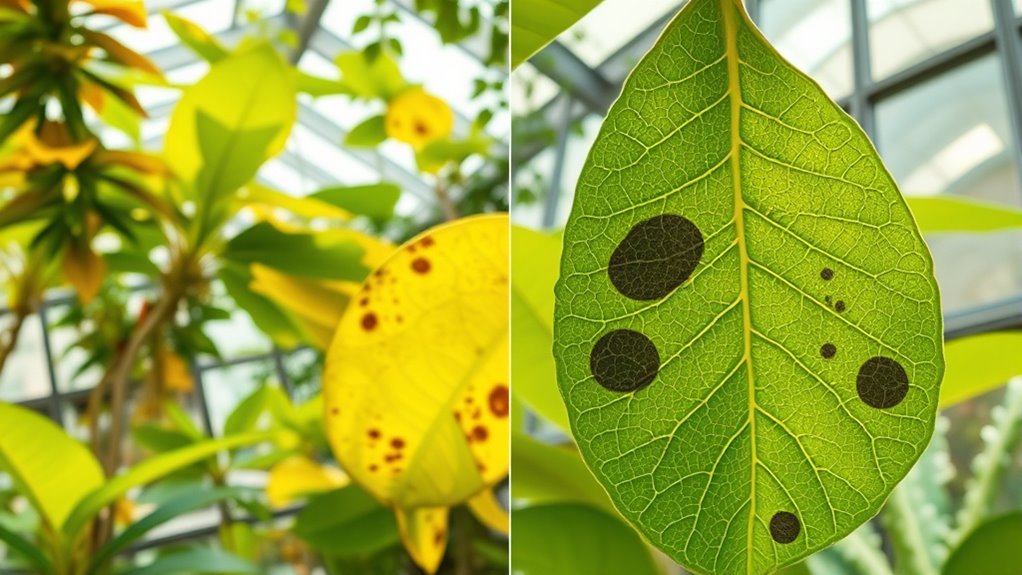
You need to learn how to spot viral symptoms, which often include mottled leaves, stunted growth, or unusual patterns. Implementing regular assessments of plants can help in early detection of viral issues before they spread further. Managing virus spread starts with quick identification and isolating affected plants.
Recognizing Viral Symptoms
Viral infections in greenhouse plants often present subtle yet distinctive symptoms that can be mistaken for other issues. Recognizing these signs is *vital* for early intervention. Look for unusual mottling, streaks, or mosaic patterns on leaves, which are common indicators. You may also notice stunted growth, leaf distortion, or premature leaf drop. These symptoms can sometimes resemble nutrient deficiencies, so careful symptom identification is key. Keep in mind that virus transmission often occurs through contaminated tools, insects, or infected plants, making prevention essential. To identify viral diseases accurately, observe the following: – Mosaic or mottling patterns on leaves – Leaf curling or distortion – Stunted or uneven growth – Unusual coloration or streaks – Premature leaf drop. Staying informed about disease transmission methods can help prevent outbreaks and protect your greenhouse. Additionally, understanding how plant immune responses work can aid in developing effective management strategies. Recognizing energetic alignment in plant health may also provide novel insights into disease prevention. Monitoring technological advancements in plant diagnostics can enable quicker detection and response. Quick detection helps limit spread and protects your greenhouse.
Managing Virus Spread
Controlling the spread of viruses in your greenhouse requires diligent management and preventive measures. Start by implementing strict quarantine procedures for new plants before introducing them to your existing stock. This helps prevent infected plants from spreading the virus to healthy ones.
Regularly follow disinfectant protocols by sanitizing tools, equipment, and surfaces to eliminate any lingering pathogens. Be consistent with these practices, especially after handling infected plants or working in different sections of the greenhouse. Maintaining proper sanitation is crucial to reducing transmission risks.
Keep your workspace clean and monitor plants closely for any early viral symptoms. Educate staff about virus transmission to ensure everyone follows proper hygiene and handling procedures. Incorporating plant health monitoring practices can further reduce infection risks, and staying informed about grocery store hours can help ensure timely access to necessary supplies for your operation. Additionally, understanding how viral diseases spread can aid in developing more effective control strategies. Staying updated on lifecycle management of pests and pathogens can also enhance your disease prevention efforts.
Pest-Related Diseases and Damage
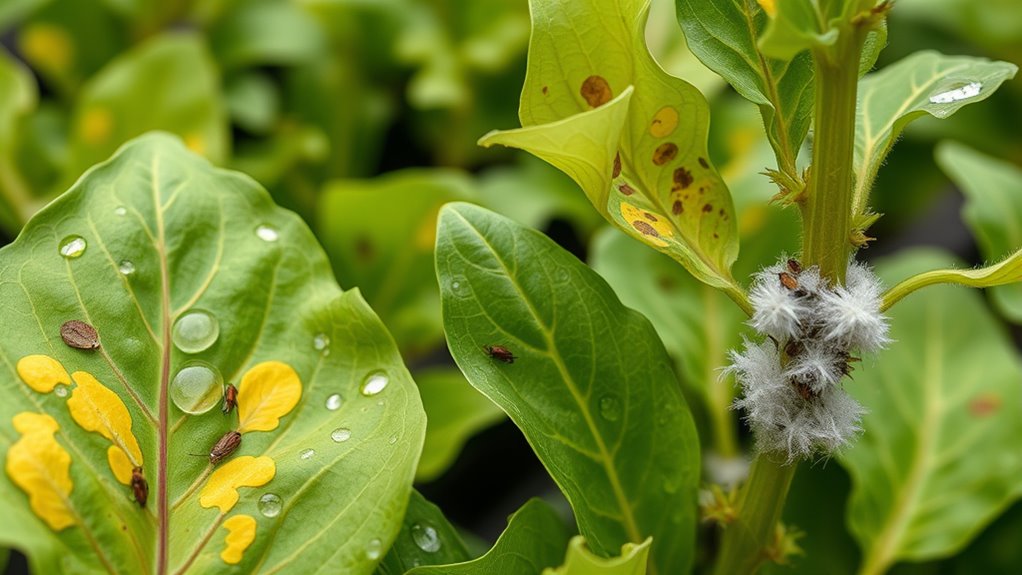
You’ll notice certain pests like aphids, whiteflies, or spider mites attacking your plants. Look for signs such as distorted leaves, sticky residue, or webbing, which indicate pest activity.
Recognizing these damage signs early helps you take quick action to protect your greenhouse.
Common Pest Infestations
Pest infestations are among the most common and damaging issues faced by greenhouse plants. You’ll often see pests like aphids, spider mites, whiteflies, mealybugs, and thrips causing harm. These pests can quickly multiply and weaken your plants, making early identification vital.
Introducing beneficial insects, such as ladybugs or predatory mites, can naturally control pest populations. Regular monitoring helps catch infestations early.
When needed, carefully applying pesticides can reduce pest numbers without harming your plants or beneficial insects. Be mindful to avoid overuse of pesticide application, which can lead to resistance or damage to your plants.
Keeping your greenhouse clean and maintaining proper humidity levels also helps prevent infestations from taking hold. Staying vigilant ensures healthier, pest-free plants.
Signs of Damage
Recognizing the signs of damage caused by pests is essential for maintaining healthy greenhouse plants. Look for visible indicators like discolored or deformed leaves, which often signal pest activity or nutrient deficiencies.
Damaged foliage may exhibit spots, holes, or webbing, suggesting pest presence. Water stress can also mimic pest damage, causing wilting, yellowing, or browning leaves.
Be alert to uneven growth patterns or stunted plants, which can result from both pests and nutrient imbalances.
Keep an eye out for sticky residues or mold, as these are signs of pest excretions.
Early detection of these symptoms helps you distinguish between pest-related damage and issues like water stress or nutrient deficiencies, enabling prompt treatment and healthier plants.
Environmental Factors Contributing to Plant Diseases
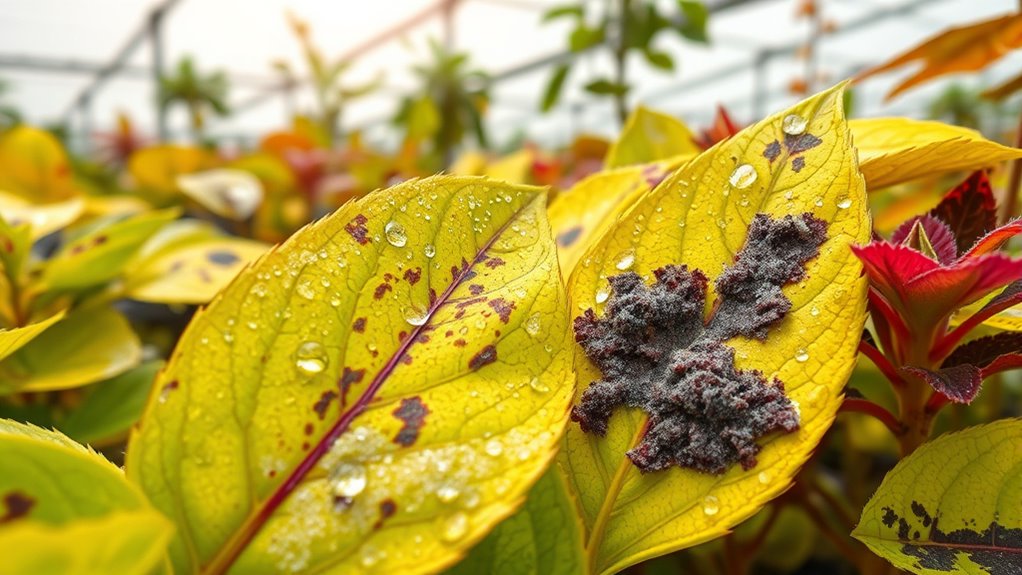
Environmental factors play a crucial role in the development and spread of plant diseases in greenhouses. Poor soil pH balance can weaken plants, making them more vulnerable to pathogens.
Incorrect watering practices, such as overwatering or inconsistent schedules, create humid conditions that promote fungal growth. Humidity levels, airflow, and temperature fluctuations also influence disease prevalence. You should monitor these conditions carefully to prevent issues.
Additionally, factors like contaminated tools or surfaces can introduce pathogens. Keep in mind these key points:
- Imbalanced soil pH levels
- Excessive or irregular watering practices
- High humidity and poor ventilation
- Temperature fluctuations
- Contaminated equipment or surfaces
Managing these environmental aspects helps reduce disease risks and maintains healthy greenhouse plants.
Preventative Measures and Treatment Strategies
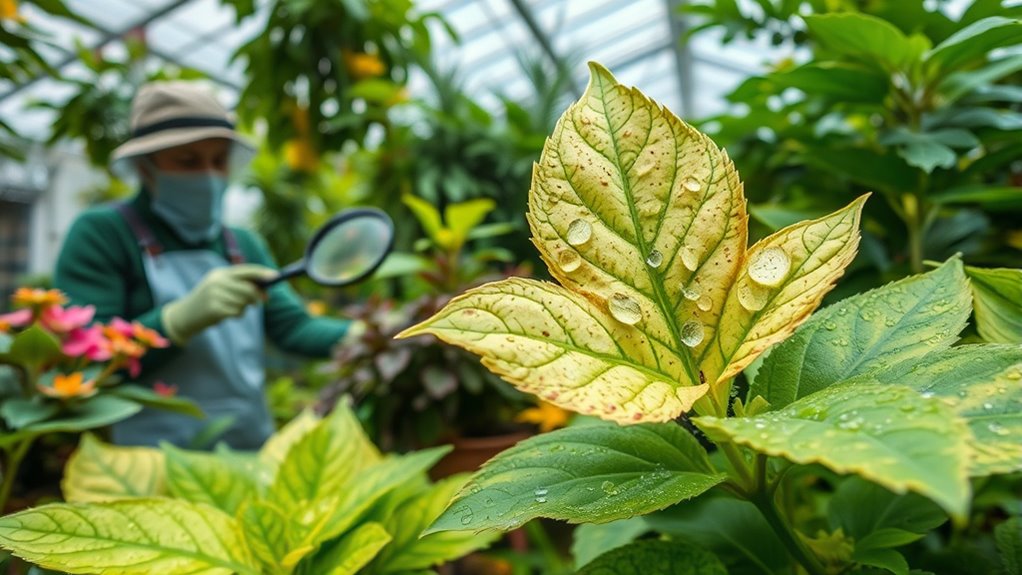
Implementing effective preventative measures is the best way to protect your greenhouse plants from diseases before they start. Start with cultural controls, such as maintaining proper sanitation, ensuring good air circulation, and avoiding overwatering. These practices reduce the chances of pathogen growth.
Incorporate an Integrated Pest Management approach to monitor pests and prevent infestations that can introduce diseases. Regularly inspect your plants for early signs of trouble, and remove infected tissue immediately.
Use resistant plant varieties when possible. Keep tools sanitized and avoid overcrowding to minimize stress on your plants.
Frequently Asked Questions
How Can I Accurately Diagnose a Specific Disease in My Greenhouse Plants?
To accurately diagnose a specific disease in your greenhouse plants, start by observing disease symptoms closely, noting any discoloration, spots, or wilting.
Use diagnostic techniques like examining leaf samples under a microscope or conducting lab tests for pathogen identification.
Comparing symptoms with trusted disease guides can help.
Taking prompt, detailed notes and photos guarantees you have accurate information to determine the correct disease and treatment.
Are There Natural or Organic Treatments for Greenhouse Plant Diseases?
Think of your greenhouse as a thriving garden of life, where natural remedies act as guardians. You can use organic fungicides and biological control methods to fight diseases without harming your plants or the environment.
These eco-friendly treatments help maintain balance, like a gentle breeze clearing away trouble. By choosing organic options, you nurture a healthy, resilient greenhouse where plants flourish naturally and safely.
How Long Does It Take for a Treatment to Show Results?
When asking how long it takes for a treatment to show results, consider disease incubation and treatment duration.
Usually, you’ll see improvements within a week or two, but it varies based on the disease’s incubation period and treatment type.
Natural or organic treatments often take a bit longer than chemical ones.
Keep monitoring your plants closely, and if symptoms persist beyond two weeks, reapply or try a different approach.
Can Healthy Plants Recover Fully After a Disease Outbreak?
Imagine your plant donning a tiny superhero cape, ready to bounce back. Yes, healthy plants can recover fully after a disease outbreak, thanks to their plant resilience.
With proper care and treatment, they often bounce back stronger than ever. Disease recovery depends on early detection and intervention.
What Are the Best Practices to Prevent Disease Spread Between Plants?
To prevent disease spread between plants, you should practice good plant sanitation by regularly cleaning tools and removing debris.
Guarantee proper pest control since pests can carry diseases from plant to plant.
Maintain adequate spacing for airflow, avoid overwatering, and monitor plants frequently for early signs of trouble.
Conclusion
Don’t let diseases discourage you—early identification and proper treatment can save your greenhouse plants. While it might seem overwhelming at first, implementing good hygiene, monitoring regularly, and staying vigilant make a big difference. Remember, even experienced gardeners face challenges, but with knowledge and prompt action, you can keep your plants healthy and thriving. Trust your instincts, stay proactive, and enjoy the rewarding process of nurturing a vibrant, disease-free greenhouse.
